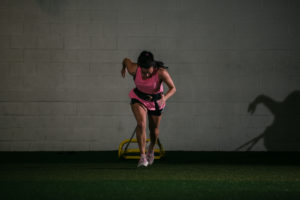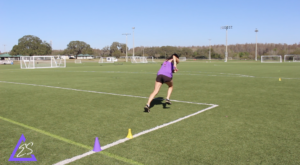
08 Nov Maybe Your Kid Just Isn’t Fast: Speed Hard Truths
It can be frustrating to see your young athlete as the slowest one out there.
They’re a step behind every play, they lack that electric spark, and it just seems every time they sprint, they’re running through mud.
Maybe your kid just isn’t fast. Maybe they’ve done physical development totally wrong. Maybe they specialized early. Maybe they never ran a max effort sprint in the neighborhood. Maybe they have terrible genetics. And maybe, they never worked hard to do anything about it.
When a young athlete is slower than the rest, there are a few things to consider as to why this is happening.
Let’s start with the uncontrollable bad news first, then I’ll provide some good news on what can be controlled. Either way, there are several hard truths in this article that will shed a light on how seriously athletes must take speed training.
Enjoy.
The Bad News
First and foremost, speed is about 70% genetic.
Some athletes are born with the ability to produce more force rapidly than others. This can come from their anatomy and physiology, with body shape playing a massive role. More often than not, mesomorphs run faster because they have lean muscle mass and a higher percentage of fast twitch muscle fibers. This allows them to have a higher stride cadence, or higher rate at which their foot hits the ground. The fastest athletes have the shortest ground contact time, and the ball of the foot is able to strike the ground in a split second.
The activities and sports that an athlete’s parents participated in translate to a child’s speed ability as well. If both parents were endurance athletes (cross country or long distance track events), they’re more likely to pass on slow twitch muscle distribution to their young athlete.
If this is your scenario, then read on because there is a lot that can be done to build apex sprinters.

The Good News
Just because a kid’s genetics are doomed, doesn’t mean hope is lost and they can’t improve their speed. They absolutely can make serious gains. The human body is incredibly adaptable and powerful when provided with the proper stimulus for many years in a child’s long-term physical development pathway.
Speed can be “hardwired” with consistent sprint training year-round. Even better, a kid who is just embarking on a speed training journey is more likely to experience more gains when they start just before their growth spurt.
However, this doesn’t mean they need an advanced program right off the bat. Youth athletes that are ages 8-12 benefit from building coordination, rhythm, balance, and body awareness through the use of fun games and competitions. Since they are still physically and mentally maturing during this time period, it bodes well to expose them to a variety of environments that build their athleticism. There’s no need for parachutes, weighted sleds, over coaching mechanics, and making them line up on the end line.
Have them race. Have them chase. Have them tag. Have them compete. And most importantly, make speed training fun!
Simplicity Wins
Since speed development takes time, young athletes must develop good habits. When they’ve played enough in their childhood and built the necessary athletic skills to be able to express speed during adolescence, they’re ready for a more formal plan that is to be taken seriously and done religiously.
To start, they need to commit to 2x a week of speed work. Of course, one day of training is better than nothing, but they will see progress a lot quicker if they train speed 2x a week in the off season.
Once they’ve developed the habit of 2x a week speed, they can add a third day in the off-season to bolster their gains even more.

Simplicity is the foundation of any speed workout. A typical workout should only be a handful of plyometric and jump drills, mechanical work done perfectly (don’t just go through the motions!), and then a few max velocity sprints with a 5+ minute rest in between.
Ideally, a speed workout shouldn’t be more than 20 minutes. The goal isn’t to tire an athlete. Instead, they should be feeling “lit up” and excited after a speed workout.
For a speed program with drills, sets, and reps GO HERE
High Outputs, Long Rest
Think of all of the adjectives that describe the best field and court athletes from a physical standpoint.
Maybe you said “explosive” and “powerful.” Very rarely, do people describe the best athletes as “well, they’re a great long slow distance runner!”
The best athletes are electric and leave their opponents in the dust.
The best athletes are electric and leave their opponents in the dust. Click To TweetIf we want to build athletes into explosive predators, we have to train them this way. Speed and intensive plyometric work should not last more than 5 seconds. Mind you, this 5 seconds of work should be the highest possible output. Even when an athlete performs a high knee drill, it needs to be done with intensity so the central nervous system is trained to go fast.
Sprint workouts also need to be done well rested and fresh.
Never do them after skills training or practice. The nervous system will be too exhausted by this point, and an athlete will not get the most out of fast twitch muscle fiber recruitment.
For a speed program with drills, sets, and reps GO HERE
Tracking
What gets measured, improves.
Athletes will have no clue if their speed program is effective, unless they are meticulous with tracking their sprint times over several months, and years.
Athletes will have no clue if their speed program is effective, unless they are meticulous with tracking their sprint times over several months, and years. Click To TweetEspecially with youth, they’ll make speed gains organically as they grow and mature, and plow through puberty. Add the consistent training stimulus on top of growth, and this creates a potent recipe for speed development.
Initially, with a new speed stimulus, athletes will make gains rapidly in the first few months, and then eventually need progression to continue to improve by the millisecond.
Here is the timeline of a 15-year-old female soccer player on her 10M Fly times. You’ll notice it was a gradually improvement because as Tony Holler says, “speed grows like a tree.”
May 2022 – 1.34 seconds 16.6 MPH
June 202 – 1.30
July 2022 – 1.36
August 2022 – 1.22 18.3 MPH
You’ll notice she took a dip in July, which is normal: athletes aren’t supposed to beat their records all the time. However, when she re-assessed at the end of Summer, she got 1.22 seconds and it took four months to get her from 16.6 MPH to above 18 MPH. Keep in mind, she consistently trained speed 2x a week all Summer in the off-season.
Speed should be an enjoyable and enriching process.
Technology
I can’t reiterate enough how important it is to purchase a Freelap Timing System to time sprints (you can go HERE to purchase).
Not only is the Freelap one of the most accurate timing systems, there’s also something to be said about how having the technology ups the intensity of the athlete sprinting. You’ll find that athletes will run faster than they would if they were being hand timed because accurate technology lights a competitive fire within the athlete.
You'll find that athletes will run faster than they would if they were being hand timed because accurate technology lights a competitive fire within the athlete. Click To TweetI strongly recommend all of my remote athletes get a Freelap if they’re serious about speed improvements.
It also is fantastic for remote athletes because most of their workouts are done solo, and they need that extra motivation to run fast.
Comparing Sprint Times
Speaking of tracking with technology, athletes must compare themselves to themselves.
Sure, it’s good to compete against others and try to get higher sprint times than their peers, but depending on body type, muscle mass and body composition, build and shape, and training consistency, athletes need to compare to who they were yesterday.
A quick case study: this past year, I had two female athletes who were both 15-years-old, same height, similar weight, and who did the exact same training program. Both attended every workout. Their 10M Fly times were still SO different, and one girl was still worlds faster than the other. Why is this?
We still have to come back to genetics: one girl had a little more muscle mass than the other and put it on more quickly, and she was the faster one. Training age also played a role, as the slower girl didn’t start speed and strength training until high school, and was playing catch-up. The faster girl’s parents were also explosive sport athletes, while the slower girl’s parents weren’t athletes at all, so that’s also something.
However, the good news: the slower girl still improved her sprint times for her own standards and where she was at in her journey. She had a 1 mph increase in her speed in just a few month’s time, which is incredible.
Self improvement is the most important.
Remember, genetics do play a huge role in speed development, but given the athlete has the proper training stimulus, and is relentless about speed training, they’ll be better than they were yesterday.
For more on training the youth female athlete, check out my guide book THE STRONG FEMALE ATHLETE HERE

For online speed and strength programs for youth athletes, GO HERE


No Comments